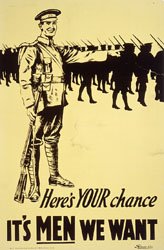11 Nov 1914 - Enlistment at Winnipeg
On Wednesday 11 November 1914, Leslie Payne and three of his friends enlisted in the No. 7 (Winnipeg) Company of the Canadian Army Service Corps in the city of Winnipeg, Manitoba, Canada. He was assigned the regimental number 515 and the rank of driver, while his friends William Percival Hogg (1892-), Robert "Bob" Valentine Moodie (1886-1956) and George Henderson "Bud" Willox (1886-1970) received the numbers 468, 470 and 529 respectively. This was a "Supply and Transport" company, which had been formed from the amalgamation of two existing Winnipeg militia C.A.S.C. companies, the 11th Company 6th Mounted Brigade and the 18th Company.
The photo below shows Leslie seated, with Bud Willox (at left) and Bob Moodie at the Campbell Studio, Winnipeg, and was probably taken at around the time that they joined up.

All four were young men - Bud was the oldest, at 28 - and while they may have been somewhat apprehensive, they would still have had some of the sense of adventure which brought them out to Canada from England and Scotland a few years earlier. However, reports of heavy casualties from the First Contingent, which had gone to Europe earlier that year, were being reported in the press, so they would not have been under the impression it was going to be something of a holiday camp. They were among a group of 62 men who signed up that day, none of whom would have had an inkling that the war would carry on for another four years, or that it would be even longer before they would return to Canada. Many, of course, would never return.
 The recruitment poster shown here - an example displayed as part of the excellent Archives of Ontario online exhibit, Canadian Posters from the First World War - is typical of those that Leslie and his friends might have seen displayed on the streets of Winnipeg during the weeks prior to their enlistment. As the text accompanying the exhibit explains:
The recruitment poster shown here - an example displayed as part of the excellent Archives of Ontario online exhibit, Canadian Posters from the First World War - is typical of those that Leslie and his friends might have seen displayed on the streets of Winnipeg during the weeks prior to their enlistment. As the text accompanying the exhibit explains:
The photo below shows Leslie seated, with Bud Willox (at left) and Bob Moodie at the Campbell Studio, Winnipeg, and was probably taken at around the time that they joined up.

All four were young men - Bud was the oldest, at 28 - and while they may have been somewhat apprehensive, they would still have had some of the sense of adventure which brought them out to Canada from England and Scotland a few years earlier. However, reports of heavy casualties from the First Contingent, which had gone to Europe earlier that year, were being reported in the press, so they would not have been under the impression it was going to be something of a holiday camp. They were among a group of 62 men who signed up that day, none of whom would have had an inkling that the war would carry on for another four years, or that it would be even longer before they would return to Canada. Many, of course, would never return.
 The recruitment poster shown here - an example displayed as part of the excellent Archives of Ontario online exhibit, Canadian Posters from the First World War - is typical of those that Leslie and his friends might have seen displayed on the streets of Winnipeg during the weeks prior to their enlistment. As the text accompanying the exhibit explains:
The recruitment poster shown here - an example displayed as part of the excellent Archives of Ontario online exhibit, Canadian Posters from the First World War - is typical of those that Leslie and his friends might have seen displayed on the streets of Winnipeg during the weeks prior to their enlistment. As the text accompanying the exhibit explains:In the early days of the war the recruitment message was fairly passive, even jovial and appealed to the pride of the prospective volunteers. But, as the war progressed the posters became more forceful calling on men to do their duty and used appropriate imagery to reinforce the message.


0 Comments:
Post a Comment
<< Home